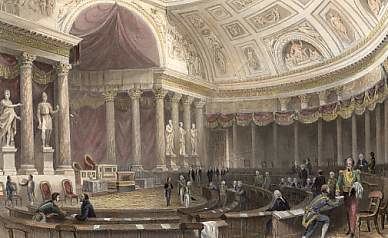 | ||
The Chamber of Peers (French: Chambre des Pairs) was the upper house of the French parliament from 1814 to 1848.
History
The Peerage of France was recreated by the Charter of 1814 at the same time as the Bourbon Restoration, albeit on a different basis from that of the ancien regime before 1789. A new Chamber of Peers was created which was similar to the British House of Lords, and it met at the Palais du Luxembourg. Like the House of Lords, the Chamber of Peers had a judicial function, being authorized to judge peers and other prominent people. As such, it judged Marshall Ney to death.
This new Chamber of Peers acted as the Upper House of the French parliament. To begin with it had 154 members, including the holders of all surviving pre-Revolutionary ecclesiastical (Reims, Langres, and Châlons) and lay peerages, except for the Duchy of Aubigny, which was held by a foreigner, the Duke of Richmond. Thirteen peers were also prelates.
New members were appointed by the king, without limit on their numbers. Such a peerage was either granted for life or was heritable, at the king's will. All men of the royal family and all descendants in the male line of previous kings (princes du sang) were members of the chamber by birth (pairs-nés), but nevertheless they needed explicit permission from the king to sit at each session of the chamber.
At the outset comprising only hereditary peers and certain prelates of the church, the Chamber became a body to which men were appointed for life following the July Revolution of 1830. In the Revolution of 1848, the Chamber of Peers was disbanded and the peerage of France was abolished.
